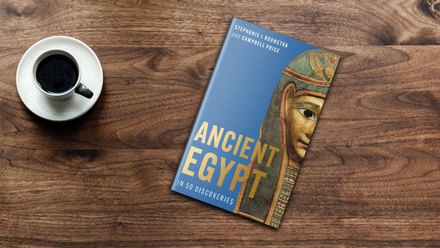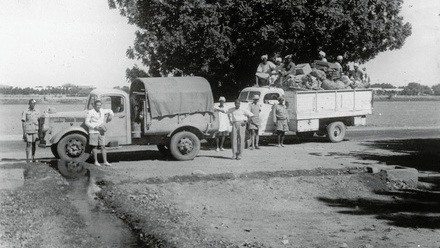Buhen: A dig house becomes a home...
by Carl Graves
At 6.30pm on November 4th 1957 Professor Bryan Emery arrived at Port Sudan aboard the M. V. Devonshire. He spent the night in the Red Sea Hotel before setting out to Khartoum to buy equipment for one of the most ambitious excavations in the history of The Egypt Exploration Society. His aim was to investigate the ancient Egyptian fortress of Buhen before the reservoir created by the construction of the High Dam at Aswan would submerge the remains forever. The site had previously been explored by D. Randall-Maciver and C. Leonard Woolley for the University of Pennsylvania expedition in 1909-1910. As a part of this investigation a dig house was constructed close to the fortress which Emery thought could be reused for his team almost half a century later. Records preserved in the EES Lucy Gura Archive document Emery’s arrival at Buhen and the time he spent renovating the house, including descriptions, plans and photographs of the refurbishment.
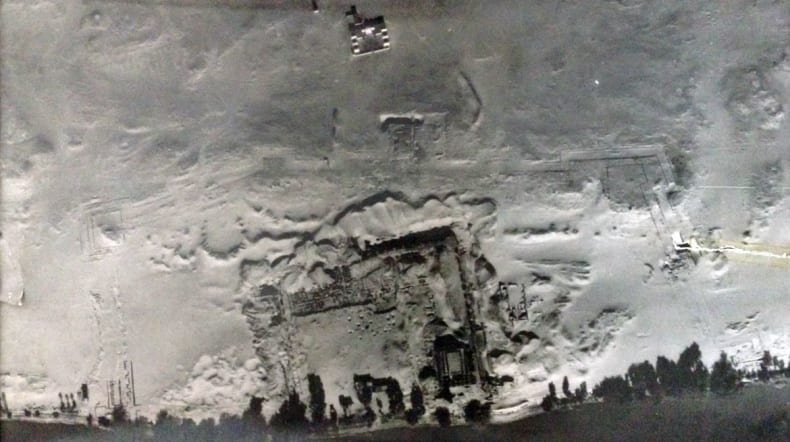 The dig house can clearly be seen to the west of the enormous excavations of the fortress in this aerial photograph.
The dig house can clearly be seen to the west of the enormous excavations of the fortress in this aerial photograph.
First reactions
Emery didn’t arrive at Buhen until the 12th November after overnight stays in Khartoum and Wadi Halfa making necessary arrangements and purchasing equipment for the expedition ahead. His first task was to inspect the dig house onsite and ensure it was suitable to accommodate the team that would be arriving to assist in the excavations as well as provide a base for EES operations in Nubia.
Emery’s first reaction is documented in the day book from 1957 now held in the EES Lucy Gura Archive:
Arrangements made for the reconstruction of the house which now cleared of sand shows a poorer state of preservation than I had expected.
Over the next few days Emery visited the site several times to organise work on the dig house. He commissioned a carpenter to build new doors and windows, as well as another to make shelving and furniture. A contractor was employed to oversee the brickwork reconstruction and stabilise the external fabric of the house.

A series of images showing the renovations of the ruined dig house. Left, the house as found by Emery before restoration. Centre, men and equipment in the central courtyard during the renovations. Right, the finished dig house with new plastered and white washed walls and wooden windows and doors fitted.
A sketch in Emery’s day book gives some idea of the living arrangements available at the house. Images, also preserved in the EES Lucy Gura Archive, show the poor state of the dig house on arrival and the subsequent work on it organised by Emery. As field director Emery had to ensure that everything was prepared on site before excavations could begin. Minute details such as the ordering of windows and doors, followed by their arrival on site (21st November 1957) are all documented in the day books. A felucca was even hired for the season to assist in bringing materials to the fortress from Wadi Halfa on the east bank.
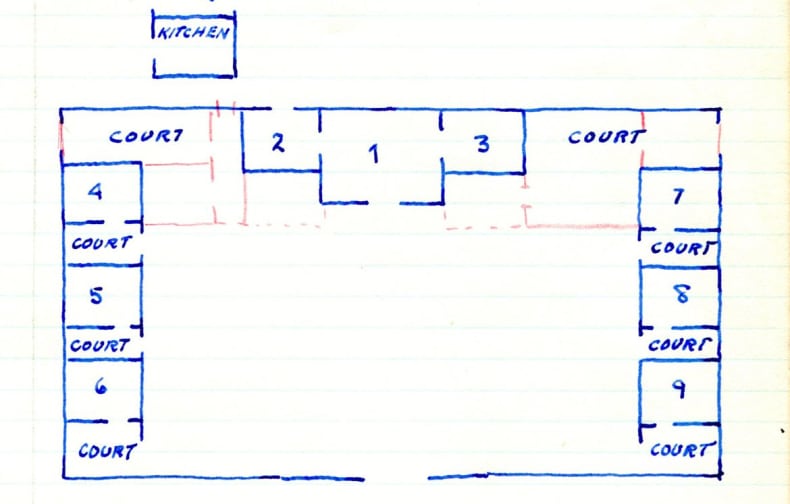 A sketch from Emery’s 1957-58 day book showing the living arrangements of the dig house.
A sketch from Emery’s 1957-58 day book showing the living arrangements of the dig house.
The dig house becomes a home
Emery finally moved into the renovated dig house on 2nd December when, with understandable relief, he wrote, ‘At last in residence at Buhen’. However, he could only live in part of the property as work was not completed until 8th December 1957.
Provision at the dig house was only made for the official dig team, while it was arranged that the local Sudanese labourers and Egyptian ‘Gufties’ were to be housed in two separate buildings hired by Emery south of the site.
…I have hired to[sic] semi-ruined building near the Buhen town which I will repair. One for the housing of local men and the other for the Gufties. The hire cost will be £7 for both houses.
Once again, Emery employed local craftsmen to carry out the necessary reconstructive work. The reroofing and renovation of these houses was completed by Dec 23rd, ‘Have now roofed the two houses which I have rented for the workmen and have also ordered the wooden doors for them’. Emery continued to use these houses for a number of seasons – although when local labour reached over 100 men in the 1959-60 season he was forced to construct huts in the desert to accommodate them all.
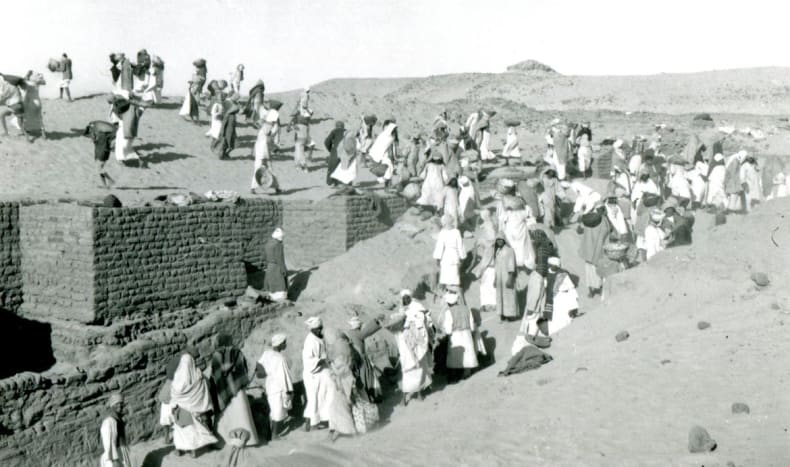 The enormous numbers of workers overseen by the EES team at Buhen can be seen here clearing the ditch of the fortress.
The enormous numbers of workers overseen by the EES team at Buhen can be seen here clearing the ditch of the fortress.
A centre for operations in Nubia
On 26th February 1958, before closing down excavations for the first season, Emery ‘gave instructions to Hassan the builder for the construction during the summer of the additions to the house. Those consist of domestic storeroom, work room, drawing office, and director’s office.’
It is likely that the bulk of the architectural drawings for the Buhen archaeological reports were prepared in the drawing office that Emery requested. A ‘large drawing table’ was commissioned by Emery in the following season on 25th September 1958, which was delivered on 1st October. Emery also records keeping costs low by furnishing the new additions to the dig house with furniture purchased from International Aeradio Limited (I.A.L), Sudan.
Further work was required during the 1959-60 season when the number of official staff meant that the courtyards between the bedrooms had to be roofed over to provide further living space. Unfortunately during the fourth season (2nd November 1960) Emery experienced a devastating rain storm, ‘the worst that the district has experienced in living memory’ which badly damaged the dig house causing him to remain at Buhen (rather than relocating to a hotel) ‘to superintend the repair work on the house – a big job’ on 4th November 1960.

The dig house becomes a home. Left, Molly Emery feeding the one of the dogs at the house. Right, the dig team in conversation at the front entrance to the central courtyard.
The Buhen dig house continued to provide a home away from home for the dig teams working in Nubia throughout the Nubian Salvage Campaign and was last inhabited during the 1964 season before it was completely submerged beneath the rising waters of Lake Nasser. The building itself may have gone, but due to the careful recording of everything during dig seasons by Professor Bryan Emery the dig house can be brought back from its watery grave through descriptions, plans and photographs now preserved in the EES Lucy Gura Archive.
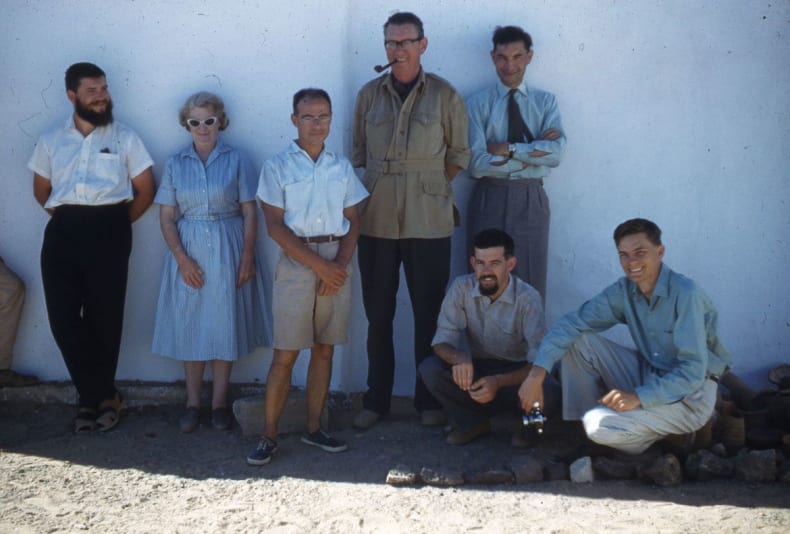 The third season dig team on Christmas Day 1960. From left to right: Tony Mills, Molly Emery, Ricardo Caminos, Bryan Emery, Harry Smith (standing), David O’Connor, Robert Deane.
The third season dig team on Christmas Day 1960. From left to right: Tony Mills, Molly Emery, Ricardo Caminos, Bryan Emery, Harry Smith (standing), David O’Connor, Robert Deane.
A lasting record
The records kept by the EES document over 130 years of excavation in Egypt and Sudan. It is our duty to preserve a lasting record of those discoveries for benefit of future research. A forthcoming collection highlight will give more details of developments in the way that we are managing our collections and making them more accessible, not just through news pieces like this, but also through FREE open access events and provision of dedicated research spaces.
Our role in caring for the Archive is to ensure its preservation for future generations. One of the ways we can do this is to digitise those materials suitable for scanning and photography. One example is the 1957-58 day book of the Buhen excavations.
 The Buhen dig house as viewed from the north east across the desert
The Buhen dig house as viewed from the north east across the desert

